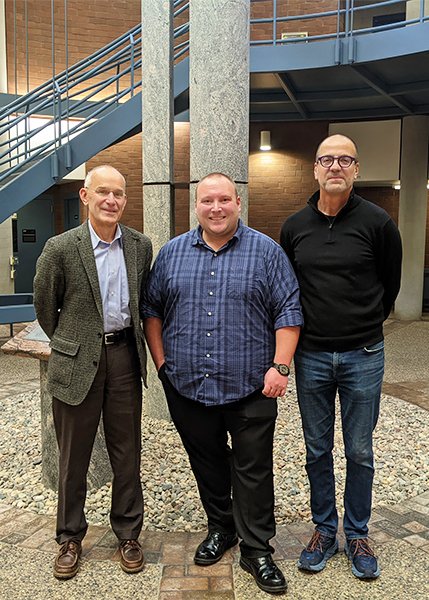Dan Kennedy has something to be thankful for

Wednesday morning, November 23, 2022, the day before the Thanksgiving holiday, Daniel Kennedy presented his research and successfully responded to probing questions from his advisory committee, including his advisors Profs. Bojan Guzina and Joe Labuz. Thus he completed his Ph.D. degree requirements and earned a new title, Dr. Kennedy.
The topic of Kennedy's research was "Nondestructive Detection of Foundation Pile Embedment Depths for High Mast Light Towers." This work grew out of a problem with large signs and towers toppling, or nearly toppling, in strong winds. The foundation systems, typically built with steel H-piles or concrete-filled steel pipe piles connected to a triangular concrete pile cap, are at risk of overturning in peak wind loadings if the foundation piles are not sufficiently deep enough to provide the designed uplift capacity. However, records of pile lengths are not available for several hundred high mast light towers (HMLTs) throughout Minnesota. Without prior knowledge of the in situ pile lengths, an expensive tower foundation replacement effort would need to be undertaken.
Kennedy worked on the development of a non-destructive screening tool to determine the in situ pile length. The tool could provide significant cost savings compared to replacing or retrofitting all towers with unknown foundation geometries. The aim of Kennedy's research was to establish non-destructive field-testing techniques, including data analysis algorithms, for determining in situ pile embedment depths by way of seismic waves. The embedment depth of each pile supporting an HMLT is identified through a systematic sensing approach that includes (i) collection and classification of the pertinent foundation designs and soil conditions, (ii) use of ground vibration waveforms captured by a seismic cone penetrometer (SCP), (iii) three-dimensional visco-elastodynamic finite element analysis (FEA) used as a tool to relate the sensory data to in situ pile length, (iv) use of machine learning algorithms, trained with the outputs of FEA simulations, to solve the germane inverse problem, (v) HMLT field testing, and (vi) analysis-driven data interpretation. In principle, the scarcity of existing HMLT configurations with known pile depth creates an absence of field data needed to adequately train a machine learning algorithm. However, Kennedy's work demonstrates that the use of FEA simulations as proxy training data for the machine learning algorithms leads to a robust data interpretation scheme.
In addition to adding to our understanding of nondestructive detection of foundation pile embedment depths for high mast light towers, Daniel Kennedy's work also helped him land a position as a geotechnical engineer with Barr Engineering. Congratulations, Dr. Kennedy!